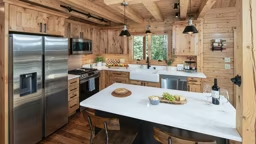
Photo: fotolia.com/DragonImages
Once you know where your home will be located and have made your basic design decisions, you’re ready to have detailed plans drawn up. The best place to go for your construction documents is a designer. This can be an architect, an independent home designer or someone who works directly for the log or timber home company of your choice.
Normally, producers require an upfront fee as a deposit for the design and draft work before they will produce working drawings for you. The financial outlay is well worth the investment and is typically deducted from the cost of the home when you sign your sales contract.
Design renderings obtained from producers may not include schematics for the mechanical and electrical components of the home, which are necessary to get building permits. However, in nearly all cases, your electrical or plumbing subcontractor will be able to provide the needed detailed drawings.
Architects and designers are available around the country. Their services often include construction supervision in addition to design and materials specification. If you’re creating an intricate floor plan with many unusual features, an architect is a good choice for expert assistance. Make sure you have the architect coordinate with the log or timber producer and that he/she understands the differences in the requirements of these homes, such as increased wall thickness and foundation needs.
In addition to independent architects, many log and timber home companies employ in-house designers and draftspeople who have expertise in building codes and home design and can create the drawings for your home. They do excellent work, have a large cache of plans to peruse for ideas and are a good place to go for the finished set of blueprints you’ll need. Their fees are generally considerably lower than an architect’s because the service they provide is not as extensive.
Construction Drawings
Construction drawings are created so that as much information as possible can be communicated to the builder in as little space as possible. A basic set of construction drawings will include:- Elevations showing four views of the house, one for each exterior wall as viewed from the yard looking at the home. These two-dimensional drawings show what the home will look like when completed.
- A plan view showing the home as viewed from the top with the roof removed. There is one plan view for each floor. It shows the interior of the home, indicating sizes, shapes and arrangements of rooms, doors, windows, bathroom fixtures, kitchen equipment, etc.
- A section view, generally an enlargement of a specific construction detail that is hidden from view. Imagine taking a large knife and slicing through a wall or portion of the foundation, opening up that area to show what lies within.
- Foundation drawings showing the foundation in an elevation view, a plan view and a section view to make sure the construction details are clear.
- Mechanical detail showing the three mechanical components: electrical wiring and equipment; plumbing and fixtures; and heating and air conditioning. Generally, the subcontractors responsible for installing this material and equipment are provided with a copy of the working drawings. They then develop drawings covering their work and use these to obtain permits.
- Specifications for lumber size and grade, strength of concrete, wall finish, grade of roofing and so on through all the details of construction materials. These figures appear in tables or notes that accompany the blueprints.
Survey & Plot Plan
A survey is a plan view of the property showing exact size, shape and location in relation to some reference point. Most cities and counties require a survey whenever land or property is sold. Mortgage companies require this information prior to providing financing. Surveys, when prepared and signed by licensed land surveyors and filed with the appropriate city or county government agency, are accepted as accurate in most legal proceedings.
A survey and plot plan should contain compass direction showing north; measurements and bounds of the property lines and their distances; lot corners; location and dimensions of the house, garage and other buildings planned for the site; and other elements that involve improvements to the property.
Copies of Drawings
A complete set of construction drawings can be five to ten pages long. Since reproducing and collating these drawings is expensive, anticipate how many copies of the working drawings you are likely to need so you can order enough, but not too much. Here are the copies you will definitely need:
- Master set. These are the original black-and-white drawings maintained by the home producer, architect or home planner. It’s also the set to be used when making additional copies.
- Sets for building permits. The number of sets needed for building permits will vary, depending on the number of individual permits needed and the number of copies required by each permit-issuing agency. Check with appropriate agencies in your area for advice.
- Sets for contractors. The general contractor and each subcontractor will need a set of prints in order to perform their work. Before they are actually selected, you will need sets for every contractor you ask to bid on work for the project. Generally these contractors will return the prints or share them. It is also possible to send these contractors something less than a full set of prints. They only need the portion that shows the work they will bid on. It is usually advisable to plan on at least one set each for the general contractor, excavator, electrician and HVAC contractor.
- Sets for lender(s). You will need at least one set of plans to submit with your loan application. If you’re applying to more than one lending institution, you’ll need a set for each.
- Sets for job site. A complete set of working drawings should always be available on the job site for inspectors and everyone working on the project. It is a good idea to have this set laminated to keep the drawings clean and legible.
- Sets for owners. As the homeowners, you will want to keep a complete set of plans with you so you can monitor progress at the job site and have a reference copy in case others are lost or damaged.











